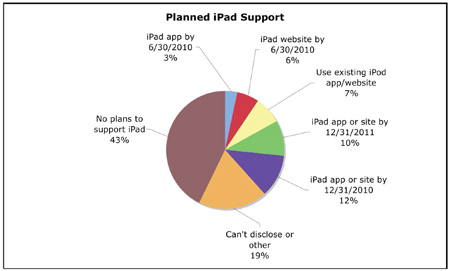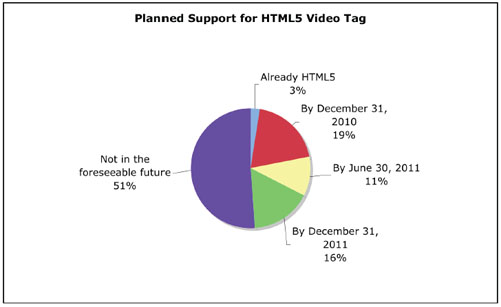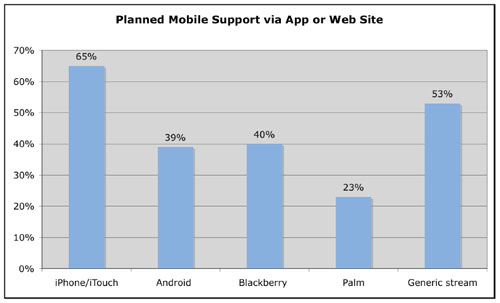iPad and HTML5 Support: Hype or Reality?
No two topics are hotter in the world of online video right now than the iPad and the HTML5 Video tag. But how many organizations are actually making the necessary changes to make their content ready for Apple's tablet and moving to adapt to the HTML5 Video standard? A new report from StreamingMedia.com contributing editor Jan Ozer separates the hype from the reality.
The report, Supporting the iPad and HTML5: Timing, Motivations, Costs, and Scope, is based on a survey conducted by StreamingMedia.com and Database Trends and Applications in April 2010. The survey received 1,147 responses from a wide variety of organizations-media/entertainment, enterprise, education, government, and non-profit/worship-and the 41-page survey report looks at the findings in general, while the 722-page appendix breaks the results down by organizational type, revenue, target market (B2B, B2C, or B2Both), and number of deployed video files.
iPad Support
The results were both surprising and compelling. Twenty-eight percent of the respondents either currently support the iPad with an app or website or plan to support it by the end of 2010, with an additional 10% planning support by the end of 2011. But 57% said they had no plans to specifically support the iPad. Note that this does not mean those organizations' sites won't work on the iPad at all, just that the respondents don't plan to optimize their current site for iPad viewing using compatible video.

Not surprisingly, media and entertainment companies are leading the way, with 36% planning iPad support by the end of 2010 and only 27% having no plans to support the device.
The report details the respondents' specific plans for iPad-targeted content, feature sets (and how they compare to the companies' primary websites), monetization plans, development costs, and whether the iPad site was or will be developed in-house or via third-party resources.
HTML5 Support
The numbers were a little higher for HTML5 Video tag support, with 22% of respondents saying they already supported the video tag or will support it by the end of 2010, and another 27% saying they would support it by the end of 2011. But this support won't be exclusive; the respondents intend to support the HTML5 Video tag with fallback to Flash, Silverlight, or other plug-in based technology, suggesting that, as Ozer writes, these organizations aren't running away from Flash or Silverlight so much as they're running towards HTML5.

In fact, despite the Apple-fueled anti-Flash hype, most of the respondents reported they were happy with their current video technology, whether Flash or Silverlight, and only 1% rated Flash as "poor" for performance and only 2% rated it as "poor" for stability, security, or end-user satisfaction.
Note that, despite some confusion in the marketplace, HTML5 Video tag support does not equal iPad support. "As an example, go to the Theora page on Wikipedia.org," says Ozer. "The video file won't play on an iPad, yet Wikipedia claims to be HMTL5 compatible. VP8 will only complicate matters since lots of sites may claim to be HTM5 compatible via that codec. Basically, until there's a single supported HTML5 codec that the iPad also supports, they're not the same.
"In addition, our survey respondents want to customize their iPad sites with features like adaptive streaming and DRM, which are available for the iPad but not for HTML5," Ozer continues. "They also seem to want to create a custom experience for the iPad that's different from their primary site, more tailored for the bandwidth and / or screen size. We'll see what happens, but I don't get the feeling that major sites will try to satisfy both the iPad and their computer-based customers with the same site—they certainly don't with mobile. I could be wrong, but at the very least, until the codec issue gets resolved, HTML5 support does not equal iPad support."
Mobile Support
Additionally, the survey asked respondents about their plans to support other mobile platforms, including Apple's iPhone/iPod Touch, Google's Android, RIM's Blackberry, and Palm (though the survey was administered before HP announced plans to acquire Palm). Not surprisingly, support for the iPhone/iPod Touch ranked highest at 65%, with both Android and Blackberry coming in around 40%. But even here, most respondents (53%) said they'd offer a generic video stream that's not specifically targeted at a particular mobile platform or device.

About the Report
Supporting the iPad and HTML5 was written by StreamingMedia,com contributing editor Jan Ozer, and produced in partnership with Database Trends and Applications, a magazine produced by Unisphere Media, which along with StreamingMedia.com is a subsidiary of Information Today, Inc. The original survey was created, implemented, and analyzed using www.surveymethods.com, and the survey report is 41 pages long, with 41 information tables. The full Table of Contents is available here.
The Appendix to the report contains 18 demographic-specific survey reports detailed in the Table of Contents, totaling an additional 722 pages. These additional reports allow survey purchasers to view survey data specific to their organizational type (media, non-media, educational, governmental, worship/non-profit), annual revenue, market served (B2B, B2C, B2Both), and the number of video files posted on their websites.
Report Pricing and Availability
The report is available inn three editions: report including appendices ($199.99), report only ($59.99), and appendices only ($159.99). All versions are available now for purchase and download in PDF format here.
Related Articles
Pay no attention to the man behind the Mac. HTML5 won't be a serious consideration for at least a few years.
02 Sep 2010
Silverlight and Flash both have a future, but publishers should be considering HTML5 as a way to step away from vendor lock-in and the player and plug-in wars.
08 Aug 2010